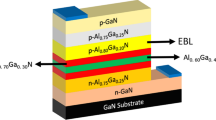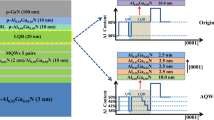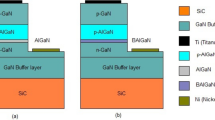Abstract
Nitride semiconductors have become the new generation of light sources for displays and optical storage. Nitride emitters are highly efficient, environmentally friendly and have a long device life. In this article, we have designed a new structure for ultraviolet light-emitting diode. The device consists of AlGaN/GaN/InGaN multi-quantum well structure. In this design, the quantum structure was engineered to increase the confinements of carriers in the quantum well. The more carrier’s confinement increases radiative recombination rate in the active region of the device and enhances the device performance. The proposed design and its performance are simulated and studied by numerical approach. Comparing to reported design, significant improvement in the intensity of output light and reduced electrical power consumption has been observed and the structure shows better performance at wavelength of 350–380 nm.







Similar content being viewed by others
References
Beeler M, Trichas E, Monroy E (2013) III-nitride semiconductors for intersubband optoelectronics: a review. Semicond Sci Technol 28(7):074022
Bhattacharya P (1994) Semiconductor optoelectronic devices. Prentice-Hall, Inc., Upper Saddle River
Chang S-J et al (2002) 400-nm InGaN-GaN and InGaN-AlGaN multiquantum well light-emitting diodes. IEEE J Sel Top Quantum Electron 8(4):744–748
Chichibu SF et al (2001) Optical and structural studies in InGaN quantum well structure laser diodes. J Vac Sci Technol B Microelectron Nanometer Struct Process Meas Phenom 19(6):2177–2183
Efremov A et al (2006) Effect of the joule heating on the quantum efficiency and choice of thermal conditions for high-power blue InGaN/GaN LEDs. Semiconductors 40(5):605–610
Fu Y-K et al (2011) The effect of trimethylgallium flows in the AlInGaN barrier on optoelectronic characteristics of near ultraviolet light-emitting diodes grown by atmospheric pressure metalorganic vapor phase epitaxy. Appl Phys Lett 98(12):121115
Gardner N et al (2007) Blue-emitting InGaN–GaN double-heterostructure light-emitting diodes reaching maximum quantum efficiency above 200 A/cm2. Appl Phys Lett 91(24):243506
Giannazzo F, Fisichella G, Greco G, La Magna A, Roccaforte F, Pécz B, Yakimova R, Dagher R, Michon A, Cordier Y (2017) Graphene integration with nitride semiconductors for high power and high frequency electronics. Phys Status Solidi A 214(4):1600460
Han J et al (1998) AlGaN/GaN quantum well ultraviolet light emitting diodes. Appl Phys Lett 73(12):1688–1690
Hu H, Zhou S, Liu X, Gao Y, Gui C, Liu S (2017) Effects of GaN/AlGaN/Sputtered AlN nucleation layers on performance of GaN-based ultraviolet light-emitting diodes. Sci Rep 7:44627
Karan H, Saha M, Biswas A (2017) Step multiple quantum well enabled performance enhancement in InGaN/GaN based light-emitting diodes. Microsyst Technol. https://doi.org/10.1007/s00542-017-3567-6
Kim A et al (2001) Performance of high-power AlInGaN light emitting diodes. Phys Status Solidi (A) 188(1):15–21
Kim M-H et al (2007) Origin of efficiency droop in GaN-based light-emitting diodes. Appl Phys Lett 91(18):183507
Kim DY et al (2015) Overcoming the fundamental light-extraction efficiency limitations of deep ultraviolet light-emitting diodes by utilizing transverse-magnetic-dominant emission. Light Sci Appl 4(4):e263
Kuo Y-K, Wang T-H, Chang J-Y, Tsai M-C (2011) Advantages of InGaN light-emitting diodes with GaN-InGaN-GaN barriers. Appl Phys Lett 99(9):091107
Kwak J, Lim J, Park M, Lee S, Char K, Lee C (2015) High-power genuine ultraviolet light-emitting diodes based on colloidal nanocrystal quantum dots. Nano Lett 15(6):3793–3799
Ling S-C, Lu T-C, Chang S-P, Chen J-R, Kuo H-C, Wang S-C (2010) Low efficiency droop in blue-green m-plane InGaN/GaN light emitting diodes. Appl Phys Lett 96(23):231101
Liu H et al (2015) Highly efficient near ultraviolet organic light-emitting diode based on a meta-linked donor–acceptor molecule. Chem Sci 6(7):3797–3804
Mahmoodi A, Jahromi HD, Sheikhi MH (2015) Dark current modeling and noise analysis in quantum dot infrared photodetectors. IEEE Sens J 15(10):5504–5509
Mohanbabu A, Mohankumar N, Raj DG, Sarkar P, Saha SK (2017) Efficient III-nitride MIS-HEMT devices with high-κ gate dielectric for high-power switching boost converter circuits. Superlattices Microstruct 103:270–284
Monemar B, Sernelius B (2007) Defect related issues in the “current roll-off” in InGaN based light emitting diodes. Appl Phys Lett 91(18):181103
Mukai T, Yamada M, Nakamura S (1998) Current and temperature dependences of electroluminescence of InGaN-based UV/blue/green light-emitting diodes. Jpn J Appl Phys 37(11B):L1358
Mukai T, Yamada M, Nakamura S (1999) Characteristics of InGaN-based UV/blue/green/amber/red light-emitting diodes. Jpn J Appl Phys 38(7R):3976
Muramoto Y, Kimura M, Nouda S (2014) Development and future of ultraviolet light-emitting diodes: UV-LED will replace the UV lamp. Semicond Sci Technol 29(8):084004
Nishida T, Ban T, Kobayashi N (2003) High-color-rendering light sources consisting of a 350-nm ultraviolet light-emitting diode and three-basal-color phosphors. Appl Phys Lett 82(22):3817–3819
Noh Y-K, Kim M-D, Oh J-E (2011) Reduction of internal polarization fields in InGaN quantum wells by InGaN/AlGaN ultra-thin superlattice barriers with different indium composition. J Appl Phys 110(12):123108
Pourhashemi A, Farrell R, Cohen D, Becerra D, DenBaars S, Nakamura S (2016) CW operation of high-power blue laser diodes with polished facets on semi-polar (20 2¯ 1¯) GaN substrates. Electron Lett 52(24):2003–2005
Rozhansky I, Zakheim D (2006) Analysis of the causes of the decrease in the electroluminescence efficiency of AlGaInN light-emitting-diode heterostructures at high pumping density. Semiconductors 40(7):839–845
Schubert MF et al (2008) Polarization-matched GaInN/AlGaInN multi-quantum-well light-emitting diodes with reduced efficiency droop. Appl Phys Lett 93(4):041102
Shen Y, Mueller G, Watanabe S, Gardner N, Munkholm A, Krames M (2007) Auger recombination in InGaN measured by photoluminescence. Appl Phys Lett 91(14):141101
Shinar J, Shinar R (2008) Organic light-emitting devices (OLEDs) and OLED-based chemical and biological sensors: an overview. J Phys D Appl Phys 41(13):133001
Song K, Mohseni M, Taghipour F (2016) Application of ultraviolet light-emitting diodes (UV-LEDs) for water disinfection: a review. Water Res 94:341–349
Straßburg M, Wehmann H-H, Waag A, Trampert A (2015) Challenges for group III nitride semiconductors for solid state lighting and beyond. Phys Status Solidi A 212(4):709–712
Xie J, Ni X, Fan Q, Shimada R, Özgür Ü, Morkoç H (2008) On the efficiency droop in InGaN multiple quantum well blue light emitting diodes and its reduction with p-doped quantum well barriers. Appl Phys Lett 93(12):121107
Yang ES (1988) Microelectronic devices. McGraw-Hill, New York
Zhao S et al (2015) Aluminum nitride nanowire light emitting diodes: breaking the fundamental bottleneck of deep ultraviolet light sources. Sci Rep 5:8332
Zhou S, Hu H, Liu X, Liu M, Ding X, Gui C, Liu S, Guo LJ (2017) Comparative study of GaN-based ultraviolet LEDs grown on different-sized patterned sapphire substrates with sputtered AlN nucleation layer. Jpn J Appl Phys 56:111001
Zhuo X-J et al (2014) Enhanced performances of InGaN/GaN-based blue LED with an ultra-thin inserting layer between GaN barriers and InGaN wells. Opt Commun 325:129–133
Author information
Authors and Affiliations
Corresponding author
Appendix
Appendix
In this section, the physical model of the device and the main parameters are reviewed briefly. Equations (1)–(35) have been used to simulate the presented device behavior. The details of physical modeling are available in references Bhattacharya (1994) and Yang (1988).
- A.
Electroluminescence Spectrum
The spontaneous emission rate depends on the photon energy:
where gj(E) is the joint density of states and fe(E) is the joint occupation probability for the valence and conduction bands also known as the emission condition. The joint density of states is analogous to the density of states for the conduction or valence band, but in this case, we are considering the number of states available to electrons and holes, which upon recombination would yield to photons of particular frequency. In order to determine the joint density of states, we use the parabolic approximation for the bands at the band edge. Recall that:
for hole in the valance band, and
for electron in the conduction band.
Then, the energy of the photon emitted when the electron with energy E2 recombines with the hole with energy E1 is:
where mr is reduced mass and E is the energy of the emitting photon. Then, we can write the energies of the electron and the hole as:
As the number of recombining electron hole pairs corresponds directly to the number of emitted photons, we can write that the total number of electrons dropping into the valence band and filling holes is exact same as number of photons in the ideal case, then:
where gc(E) is:
Therefore:
The emission condition is then expressed in terms of the Fermi distributions of the electrons and holes:
Here, fc(E) and fv(E) are the Fermi distribution functions for electrons and holes in the non-equilibrium injection conditions:
where EFc and EFv are the non-equilibrium Fermi levels or quasi-Fermi levels (due to injection) for electrons and holes. During injection, the concentration of carries can be so high that the conduction band would have much higher concentration of electrons and the valence band would have much higher concentration of holes than they would have in thermal equilibrium, which can be expressed in terms of quasi-Fermi levels moving into the bands making the SC behaving almost like a metal.
We can determine the quasi-Fermi levels based on the injection concentrations. Remember how we can calculate carrier densities in equilibrium using D.O.S function and the Fermi distribution, so the same logic applies here:
where
and
where
In the conditions, when E2 ≫ EFc, E1 ≪ EFv the spontaneous emission rate can be found as:
where
The spontaneous emission can be rewritten as wavelength function:
- B.
Optical power of LED
Depending on both the impurity profile and the external applied voltage, we can identify four current components in an LED under the forward-bias condition: (1) the electron diffusion current, (2) the hole diffusion current, (3) the space-charge-layer recombination current and (4) the tunneling current. The tunneling current is important only in a heavily doped pn junction at a small forward bias; thus, its effect is negligible in most LEDs at light-emitting current level. These current components are rewritten in the following:
Recombination inside the space-charge layer is effective if trap levels exist near the center of the forbidden gap. This process is generally non-radiative, and the component Irec does not contribute to the emission of light. Furthermore, luminescence originates from the electron diffusion current in the p side of the junction in most practical LEDs for reasons beyond the scope of present text. Consequently, we can define the current injection efficiency as:
Frequently, the hole diffusion current is negligible because of the high electron to hole mobility ratio; e.g., in GaAs, we have μn/μp = 30, and the foregoing equation can be simplified.
The injection efficiency indicates the percentage of diode current that can produce radiative recombination in the p side of the junction. The simplest recombination process is the band to band recombination, in which a free electron and a free hole recombine directly. The probable second process involves a shallow impurity state, where an electron recombines with a hole trapped on a shallow acceptor state. Alternatively, the process may involve a shallow acceptor and a shallow acceptor state. The photon energy generated in this process is smaller than Eg. In the third possibility process, via deep impurity states, photons may not be generated at all; even if photons are generated, their energy is much smaller than Eg.
To simplify the complex picture, let us take an elementary case where a non-radiative recombination process via an intermediate state is competing with the band to band radiative recombination. So, the radiative (Ur) and non-radiative recombination rates (Unr) can be defined, respectively, as (for the p-type region):
where Δn is excess electron density, τr is radiative recombination lifetime, and τnr is non-radiative lifetime. The radiative efficiency is defined as the percentage of electron that recombine radiatively:
where τ is the effective life time determined by:
The overall internal quantum efficiency can now be written as:
The most important parameter of an LED is the external quantum efficiency. It may be significantly smaller than the internal quantum efficiency because of internal absorption and reflection of light. After photons are generated in the PN junction, they must pass through the crystal to reach the surface. Some of the emitted photons are reabsorbed by semiconductor. Furthermore, even after the photons have reached the surface, they may not be able to leave the semiconductor because of the large difference in the refractive indices of the semiconductor and air. According to the theory of optics, the critical angle at which total internal reflection occurs is determined by the Fresnel equation. All rays of light striking the surface at angles exceeding are reflected. Since refractive index ranges between 3.3 and 3.8 for a typical LED material, critical angle is calculated to be between 15 and 18. For the light striking within the critical angle, the portion that comes out is given approximately by the average transmissivity:
A simple expression relating the external quantum efficiency to the internal quantum efficiency is given by:
where α is average absorption coefficient, v0 is diode volume, and A is emitting area.
The internal photon flux ϕ (photon per second), generated within a volume of the semiconductor, is directly proportional to the carrier injection rate R (pairs/cm3-s). The steady-state excess-carrier concentration Δn = Rτ (recombination rate = injection rate). Therefore, the photon flux can be expressed as:
Now, the extracted photon flux from the structure is:
where, the extraction efficiency specifies how much of the internal photon flux is transmitted out of the structure. A single quantum efficiency that accommodates both ηe and ηint is the external quantum efficiency ηext:
So, the LED output optical power P0:
Equation (34) is used to calculate the output power of LED versus injected current.
- C.
Current Voltage
The diode equation gives an expression for the current through a diode as a function of voltage. For a practical diode, expressed as:
where, I is the net current flowing through the diode; I0 is dark saturation current or the diode leakage current density in the absence of output light, v is applied voltage across the terminals of the diode, q is absolute value of electron charge, k is Boltzmann’s constant, t is absolute temperature (K) and n is ideality factor—a number between 1 and 2—which typically increases as the current decreases.
The dark saturation current (I0) is an extremely important parameter which differentiates one diode from another. I0 is a measure of the non-radiative recombination process in a device. A diode with a larger non-radiative recombination rate will have a larger I0. The dark saturation current and the ideality factor (n) are declared by diode specification documents and different values at various operated conditions defined by diode manufacture which can be used on the expression.
Rights and permissions
About this article
Cite this article
Soltani, M., Dehdashti Jahromi, H. & Sheikhi, M.H. Highly Efficient AlGaN/GaN/InGaN Multi-quantum Well Ultraviolet Light-Emitting Diode. Iran J Sci Technol Trans Electr Eng 44, 69–76 (2020). https://doi.org/10.1007/s40998-019-00238-y
Received:
Accepted:
Published:
Issue Date:
DOI: https://doi.org/10.1007/s40998-019-00238-y




